
Back to Loco of the Month homepage
Back to Sidestreet Bannerworks
.
April 2005
LGB / Aster Frank S.
by Marc Horovitz

The prototype of this engine was originally built by Henschel in 1941 for the Heeresfeldbahn (German military railway) and was found in a storage depot in 1945. It was then put into service on the Jüterog-Luckenwalder Kreiskleinbahn as locomotive Nº 1. In 1949, the engine was renumbered DB 99 4652 and continued to operate until 1965. From 1966 to 1968, it saw service on the island of Ruegen and, in 1974, it was privately purchased and named Frank S. Today, the Frank S pulls special trains on the Jagsttalbahn near Heilbronn / Stuttgart in Germany. (This information courtesy of Southern Steam Trains.)
Additional information supplied by readers—
From Andreas Weiss, Pfungstadt, Germany: Regarding the Frank S. Heeresfieldbahn Class HF 110 C, here is some more information for you and your readers. From 1984 to 1986 the Nicki S., a sister engine, was also on the Jagsttalbahn, where its boiler failed. The Jagsttalbahn ceased revenue business in freight, school trains, and historic trains, and shut down in 1988. Since then, a volunteer group has tried to resume the historic trains, with good results in the last two to three years.
From 1990 to 1992, Nicki S. was on the Bregenzerwaldbahn in Bezau, Austria, hauling historic trains. In 1993 there was a big revision in the Reichsbahn (DR) Goerlitz locomotive works in Germany. After the closure of the Jagsttalbahn, Frank S. went to Oechsle-Museumsbahn, doing work similar to that of Nicki S. on the other railways. Afterwards the engines both came to the
750mm-gauge Rügensche Kleinbahn (called "Rasender Roland") on Ruegen Island in the Baltic Sea in north eastern Germany. The engines are still there, Nicki S. in a blue-and-red livery and renamed Nicki-Frank S., hauling tourist and historic trains. Frank S. as static display in black and red color. Nicki-Frank S. is privately owned by Mr. W. Seidensticker (the "S" in Frank S.), a German textile producer with a love of trains. Ex.Frank S. belongs to Foerderverein zur Erhaltung der Ruegenschen Kleinbahnen.
From Ralf Muehlbichler, Dernbach Germany: Some years ago, Frank S. and Nicki S., two engines of the same type, were rebuilt as one engine, now called Nicki-Frank S. What was left from the "merger" ended up on static display in an Army Museum in Ingolstadt, Germany (these locomotives are ex-German Army engines).
Sadly, the Jagsttalbahn has been out of business for many years now. Even though there is interest in reopening the railroad, I am not convinced that it will ever happen. Some parts of the track system, including a bridge, have been permanently removed by a very "anti railroad" town mayor.
The origins
In 1989, LGB contracted with the Aster Hobby Company of Japan, one of the world’s premier model-steam-locomotive manufacturers, to produce a live-steam model of the Frank S. This was an interesting decision. At the time, the live-steam hobby had a foothold, but it was not large. Aster had been producing model steam engines since 1975 and had a good reputation in steam. LGB had been producing large-scale electric trains since the late 1960s, also with a good track record. So, was this a marriage made in heaven? Perhaps not.
There is no doubt that the resulting product of this union was a good one. However, it was not that well received. There are a variety of possible reasons for this. One is that, while the engine looked a lot like -- and was certainly compatible with -- LGB's plastic trains, it was truly a different beast altogether. The average large-scale railroader at the time knew little of live steam, nor was he really that interested in it. Frank S was an unwelcome metal interloper in a plastic world. Granted, LGB produced (via outside contractors) annual limited-run engines in metal, but these were always electrically powered. Sales of the steam engine were not up to expectations and they were dumped onto the market after only about a year at a price far below the original.
A large number of Frank Ss were produced (3,028). This number is in line with Aster's early production of their own engines, until it became clear that selling that quantity of a specific engine would take a long time. So why were that many Frank Ss produced? Was it optimism on the part of LGB, tough negotiating on the part of Aster, or something else?
Perhaps Aster's manufacturing techniques had something to do with it. An electrically powered, plastic locomotive can be kept in production more or less indefinitely, as long as there is demand. After a reasonable run of them, the dies are stored until quantities in the marketplace run low. The dies are then brought out again and a new batch is made.
When Aster makes an engine, they project the number that will sell, and they run that quantity all at once. Manufacturing techniques are entirely different for a metal steam locomotive than for an injection-molded plastic one. Also, the Aster Company itself mostly does assembly work, contracting with numerous independent businesses to produce the locomotive parts to Aster's specifications. Thus, it becomes difficult, if not impossible, to rerun a locomotive in any sort of cost-effective manner.
So, perhaps LGB ordered this large number, expecting to sell them off much more rapidly than they were able to. After a time, a manufacturer must recoup costs, regain warehouse space, and move on. So, Frank S was remaindered and LGB never again entered the live-steam market.
The model
So much for speculation. The fact is that LGB/Aster produced a fine model of an interesting prototype. The engine came packaged in a big, red box and it was supplied with a syringe, a screwdriver, a nozzle cleaner, a plastic cup, a pair of cotton gloves, and a set of very complete instructions in German and English. Sadly, Aster's name was misspelled on the cover of the instructions ("Astor").
This was Aster's first piston-valve model, with direction controlled by a reversing block between the cylinders, actuated by a reversing quadrant in the cab. It was beautifully painted and came equipped with LGB-style loop couplers. There is a dead-leg displacement lubricator on the right-hand running board.
The boiler is gas fired, of the single flue, poker-burner type. The gas tank rides in the tender. There's a flexible hose between the engine and tender, and the gas jet is attached to it. The jet merely snaps into place in the flue when engine and tender are coupled.
Fittings include a water glass (a little window in the backhead); a throttle, an interesting, external-spring safety valve; and a pressure gauge mounted in the roof, covered with a rubber cap that resembles a roof vent.
The control knobs on both the throttle and the gas tank are large and klunky. These were probably the biggest problem the engine had; they had built-in travel limits (usually insufficient) and, because of the internal O-ring, wanted to spring back to their former positions and wouldn't stay in place.
This, and a variety of other small niggles, lead to some after-market parts and a series of excellent articles by Kevin O'Connor about the Frank S and how to get the best from it. (These articles are also available on the Southern Steam Trains site.) When in top form, the Frank S is an excellent performer. Its six-coupled chassis and short wheelbase also made it attractive to kitbashers, and a variety of interesting modifications emerged (see "Frank the Tank" below).
The run
With the temperature in the high 40s and the sun shining brightly, this looked to be the ideal day for a steamup. I prepared the Frank S. in the usual manner, watering and oiling it. However, when I went to fuel the tender, I found that the gas would not transfer properly. The engine had sat in the garage overnight and was cold, so I poured a little hot water into the tank (which proved leaky, but adequate). That seemed to help a little and some gas went in. Then it appeared that the valve on the filling cannister was faulty, so I changed cans. A little more went in. Clearly, something was amiss. However, perhaps I had enough for a run.
I lit the fire, or tried to anyway. The gas control valve proved as problematic as I recalled it. It was exceedingly touchy. No wonder all those aftermarket products came along -- there was a definite need. The fire finally agreed to be lit, but was never truly happy, gurgling and fluttering. Just about the time that pressure came up to blow-off, the gas ran out. More frustration in trying to fill the tank, but at last enough went in for a decent run.
As pressure came up (again) I noticed that the water glass was leaking, weeping onto the cab floor. This wasn't enough to hamper performance, so I ignored it. Once blow-off had been achieved, I opened the throttle. The engine showed distinct signs of life. I moved the reversing lever back and forth a few times and the engine perked right up. Then I closed the throttle and coupled on three of LGB's Prussian coaches (which may not be correct for this engine, but I always thought they looked nice), put it into forward gear, and opened the throttle again.
The engine moved off smoothly and quietly. Once under way, the Frank S. is a remarkably nice engine to run. It is quite controllable (gas problems aside) and will poke along at prototypical speeds without complaint. The run, once commenced, was very satisfying. I was able to just sit down and watch it disappear in the distance, only to reappear on the other side a few minutes later, lap after lap. Once I have the gas problems sorted out, this engine will certainly be a favorite.
.

|
|
|
| Builder | Aster for LGB |
| Date built | 1989 |
| Gauge | 45mm |
| Scale | 1:22.5 |
| Boiler | Single flue |
| Fittings | Safety valve, throttle, pressure gauge, water glass |
| Fuel | Butane |
| Blow-off pressure | 45 psi |
| Cylinders | Two, double acting, piston-valve |
| Reversing gear | Reversing block between frames (dummy Walschaerts outside) |
| Lubricator | Displacement |
| Weight | Loco, 7 lb; tender, 3 lb. |
| Dimensions | Length over end beams (loco and tender), 17"; width, 4-1/8"; height, 5-1/2" |
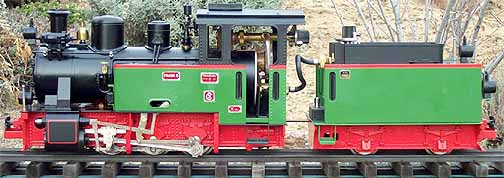
There is little difference in either side of the engine. On the right side is the dummy compressor and the lubricator, while on the left is the turbogenerator near the stack. The unsightly gas-control valve protrudes from the top of the tender.
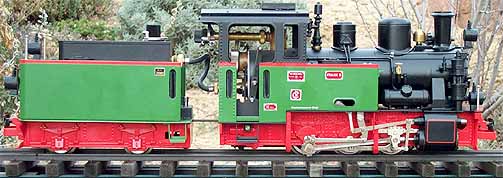
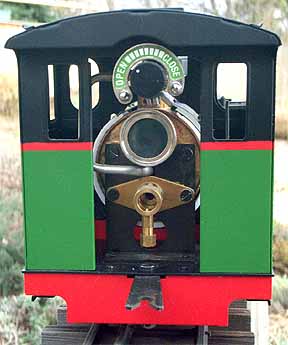
|
||||||
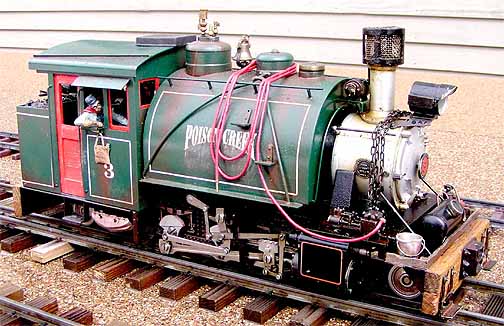 |
||||||
| . The LGB / Aster Frank S. was my first live-steam engine. The decision to buy it was a combination of the low mail-order price at that time and seeing Clark Lord's demonstration with his engine at the Big Train Show on the Queen Mary in 1992. It became "Frank the Tank" (I'm not sure who came up with the name) after the 10th National Garden Railway convention in Denver in 1994. The idea for this tank engine was stolen from Alan Olson's Acoma Nº5, which was based on a LGB electric-loco chassis.
I have built nine of these little locos and it is one of my favorites to run and watch. |
||||||
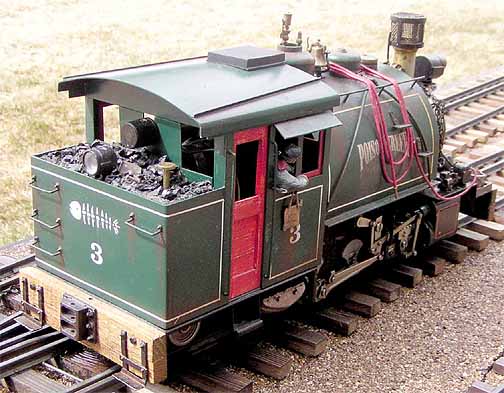 |
||||||
|
.
|
||||||
The backhead. The large throttle knob was problematic and was often replaced or modified. Presumably the German authorities having to do with toy products dictated such a "safety" device. There are also pegs to limit the travel of the valve.
.
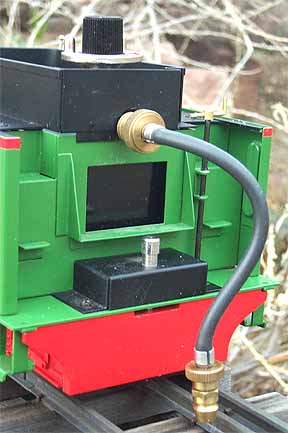
The gas tank is housed in the tender; the flexible hose connects it with the engine. The brass part hanging down is actually the gas jet, which simply snaps into the back of the flue. The silver pin on the black box is the spring-loaded coupling pin.
.
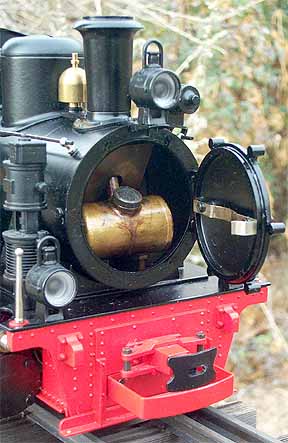
Left: The brass tank inside the smokebox is a condensate tank, another "safety" feature, though it probably does keep the engine a little cleaner. It is one of the first things to go when the engine is modified. The smokebox door snaps closed.
Below: The underside, plain and simple. The rod between the drivers controls the reversing block, which is just another piston valve. Strangely, the axles are covered by metal plates.
.

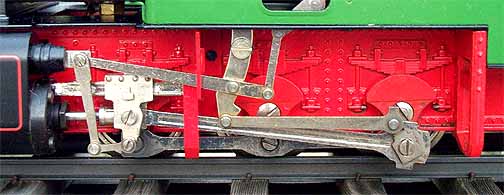
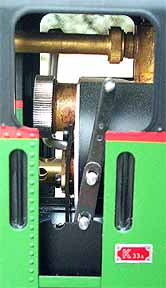
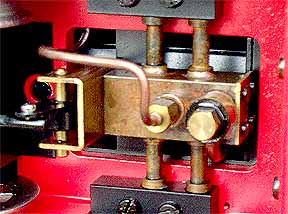
Above: Frank S's running gear. The outside plate frames, with their cast-in dummy springs, give the engine a decidedly European look.
Above right: The reversing quadrant in the cab.
Right: The model has an unusual safety valve with an external spring, based on the prototype's.

Back to Loco of the Month home page
Back to Sidestreet Bannerworks home page
This page and its contents
Copyright Sidestreet Bannerworks, 2005
.
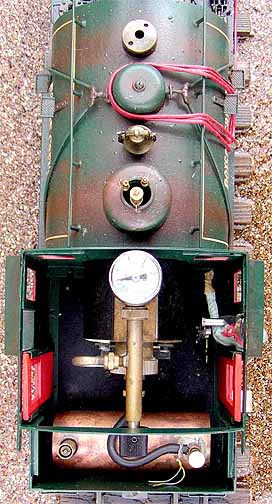 I came up with my plans by enlarging the Frank S. line drawing to full size on a copier, using a large amount of White-out, and adding what looked right. The loco was disassembled and the front and back of the frame was cut away to make room for lead and trailing trucks, which were made using the wheelsets from the tender. The cab and saddle tank were made of brass sheet and soldered together. The lubricator was moved from the side to the new front deck. The original gas valve had to be rotated 180 degrees to make the gas tank fit into the cab. The original valve has been replaced with one from Kevin O'Connor. The domes were made from copper pipe caps (turned in the lathe). The smokestack was turned and fitted with a spark arrestor made from a copper pipe-coupler and stainless-steel screen. Many details from Trackside Details and Ozark Miniatures were used to complete the locomotive.
I came up with my plans by enlarging the Frank S. line drawing to full size on a copier, using a large amount of White-out, and adding what looked right. The loco was disassembled and the front and back of the frame was cut away to make room for lead and trailing trucks, which were made using the wheelsets from the tender. The cab and saddle tank were made of brass sheet and soldered together. The lubricator was moved from the side to the new front deck. The original gas valve had to be rotated 180 degrees to make the gas tank fit into the cab. The original valve has been replaced with one from Kevin O'Connor. The domes were made from copper pipe caps (turned in the lathe). The smokestack was turned and fitted with a spark arrestor made from a copper pipe-coupler and stainless-steel screen. Many details from Trackside Details and Ozark Miniatures were used to complete the locomotive.